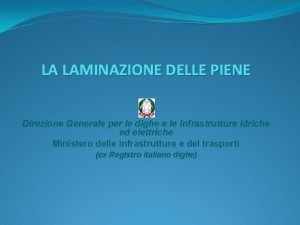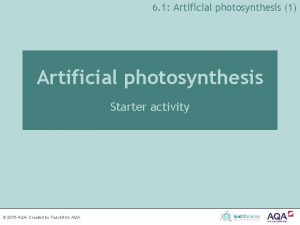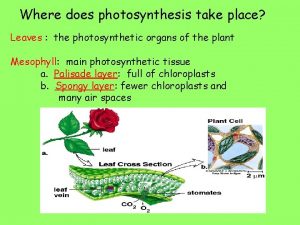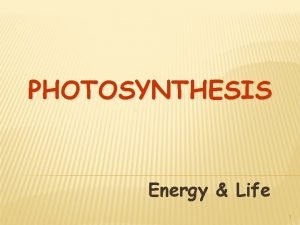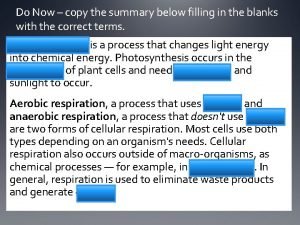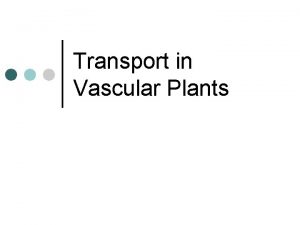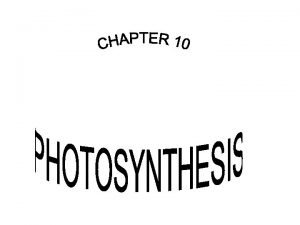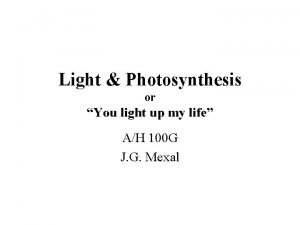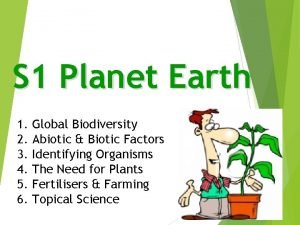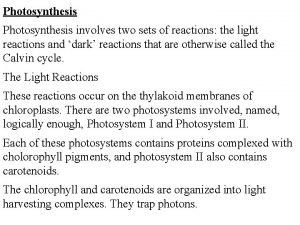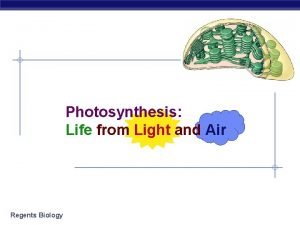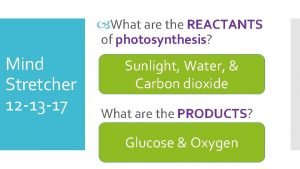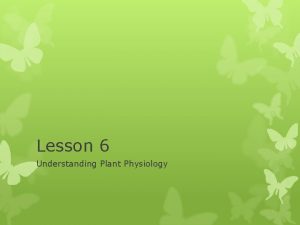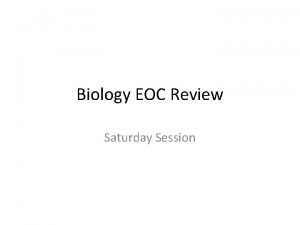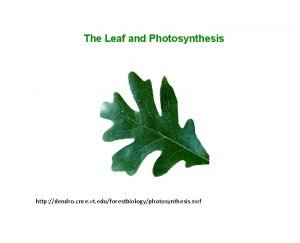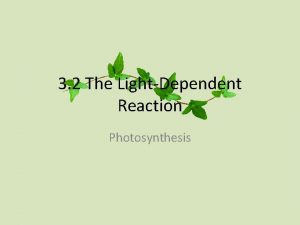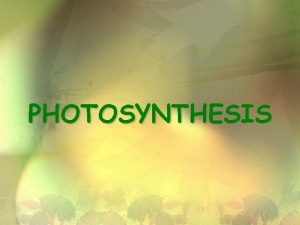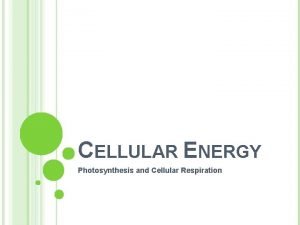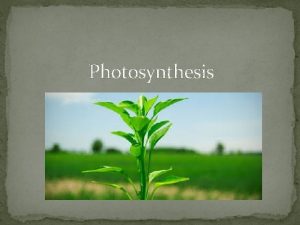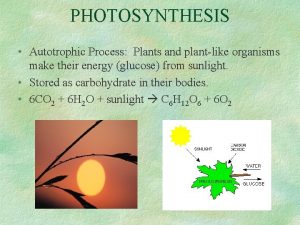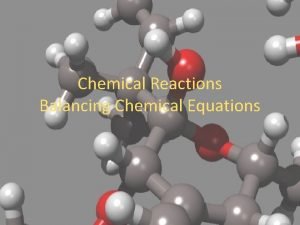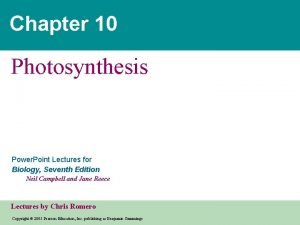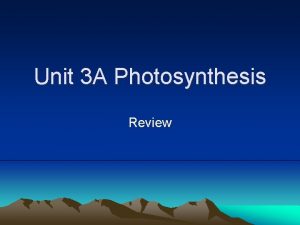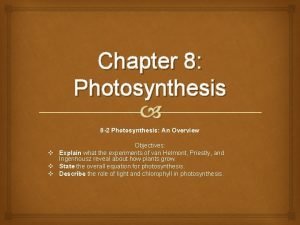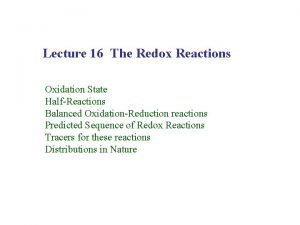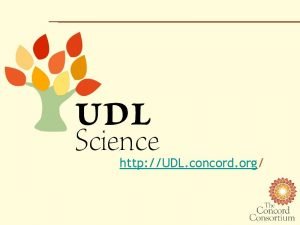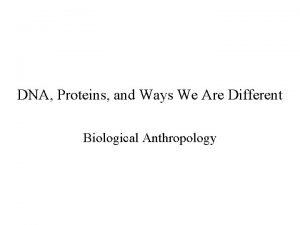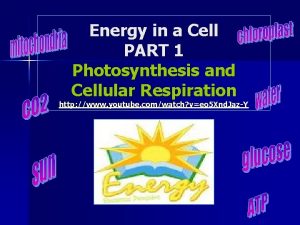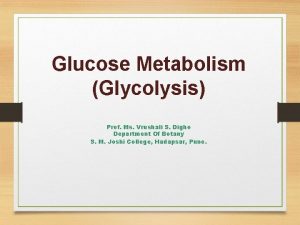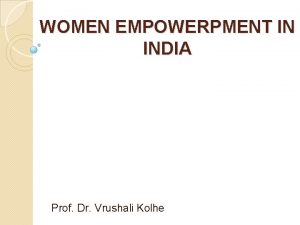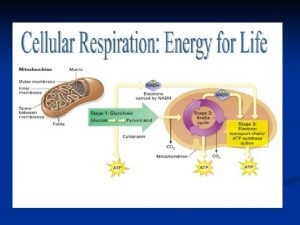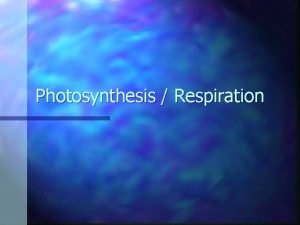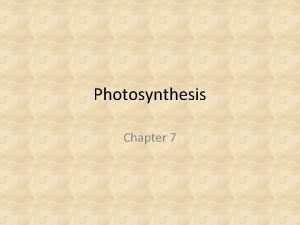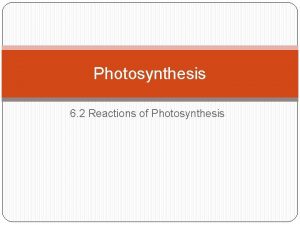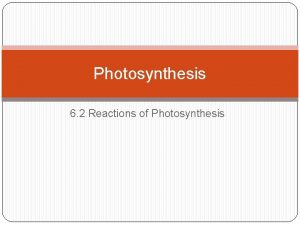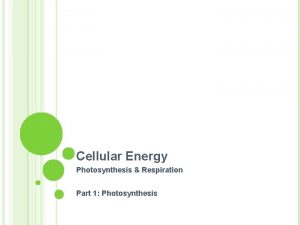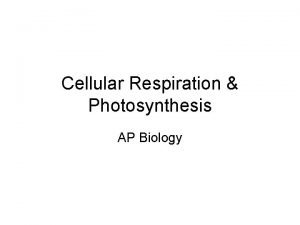PHOTOSYNTHESIS Prof Ms Vrushali S Dighe Department Of

































- Slides: 33

PHOTOSYNTHESIS Prof. Ms. Vrushali S. Dighe Department Of Botany S. M. Joshi College, Hadapsar, Pune.

THE SUN: MAIN SOURCE OF ENERGY FOR LIFE ON EARTH

THE BASICS OF PHOTOSYNTHESIS • Almost all plants are photosynthetic autotrophs, as are some bacteria and protists – Autotrophs generate their own organic matter through photosynthesis – Sunlight energy is transformed to energy stored in the form of chemical bonds (c) Euglena (b) Kelp (a) Mosses, ferns, and flowering plants (d) Cyanobacteria

Light Energy Harvested by Plants & Other Photosynthetic Autotrophs 6 CO 2 + 6 H 2 O + light energy → C 6 H 12 O 6 + 6 O 2

Food Chain

THE FOOD WEB

WHY ARE PLANTS GREEN? It's not that easy bein' green Having to spend each day the color of the leaves When I think it could be nicer being red or yellow or gold Or something much more colorful like that… Kermit the Frog

Electromagnetic Spectrum and Visible Light Gamma rays X-rays UV Infrared & Microwaves Visible light Wavelength (nm) Radio waves

WHY ARE PLANTS GREEN? Different wavelengths of visible light are seen by the human eye as different colors. Gamma rays X-rays UV Infrared Visible light Wavelength (nm) Microwaves Radio waves

The feathers of male cardinals are loaded with carotenoid pigments. These pigments absorb some wavelengths of light and reflect others. t igh ed l ect l f e R Sunlight minus absorbed wavelengths or colors equals the apparent color of an object.

Why are plants green? t d f Re te c le h lig Transmitted light

WHY ARE PLANTS GREEN? Plant Cells have Green Chloroplasts The thylakoid membrane of the chloroplast is impregnated with photosynthetic pigments (i. e. , chlorophylls, carotenoids).

THE COLOR OF LIGHT SEEN IS THE COLOR NOT ABSORBED • Chloroplasts absorb light energy and convert it to chemical energy Light Reflected light Absorbed light Transmitted light Chloroplast

AN OVERVIEW OF PHOTOSYNTHESIS • Photosynthesis is the process by which autotrophic organisms use light energy to make sugar and oxygen gas from carbon dioxide and water Carbon dioxide Water Glucose PHOTOSYNTHESIS Oxygen gas

AN OVERVIEW OF PHOTOSYNTHESIS • The light reactions convert solar energy to chemical energy Light Chloroplast – Produce ATP & NADPH • The Calvin cycle makes sugar from carbon dioxide – ATP generated by the light reactions provides the energy for sugar synthesis – The NADPH produced by the light reactions provides the electrons for the reduction of carbon dioxide to glucose NADP +P Light reactions Calvin cycle

Chloroplasts: Sites of Photosynthesis • Photosynthesis – Occurs in chloroplasts, organelles in certain plants – All green plant parts have chloroplasts and carry out photosynthesis • The leaves have the most chloroplasts • The green color comes from chlorophyll in the chloroplasts • The pigments absorb light energy

Photosynthesis occurs in chloroplasts • In most plants, photosynthesis occurs primarily in the leaves, in the chloroplasts • A chloroplast contains: – stroma, a fluid – grana, stacks of thylakoids • The thylakoids contain chlorophyll – Chlorophyll is the green pigment that captures light for photosynthesis

• The location and structure of chloroplasts Chloroplast LEAF CROSS SECTION MESOPHYLL CELL LEAF Mesophyll CHLOROPLAST Intermembrane space Outer membrane Granum Grana Stroma Inner membrane Stroma Thylakoid compartment

Chloroplast Pigments • Chloroplasts contain several pigments – Chlorophyll a – Chlorophyll b – Carotenoids Figure 7. 7

Chlorophyll a & b • Chl a has a methyl group • Chl b has a carbonyl group Porphyrin ring delocalized e- Phytol tail

Different pigments absorb light differently

Excitation of chlorophyll in a chloroplast v. Loss of energy due to heat causes the photons of light to be less energetic. v. Less energy translates into longer wavelength. e 2 Excited state Heat v. Energy = (Planck’s constant) x (velocity of light)/(wavelength of light) v. Transition toward the red end of the visible spectrum. Light (fluorescence) Photon Ground state Chlorophyll molecule (a) Absorption of a photon (b) fluorescence of isolated chlorophyll in solution

Molecular Game of “Hot Potato” Primary electron acceptor Photon PHOTOSYSTEM Reaction center Pigment molecules of antenna

Cyclic Photophosphorylation • Process for ATP generation associated with some Photosynthetic Bacteria • Reaction Center => 700 nm

• Two types of photosystems cooperate in the light reactions Photon ATP mill Water-splitting photosystem NADPH-producing photosystem

Noncyclic Photophosphorylation • Photosystem II regains electrons by splitting water, leaving O 2 gas as a by-product E Primary electron acceptor El ec tro n lec tro n tra ns po rt tra ns p or t ch ain Photons Energy for synthesis of PHOTOSYSTEM II by chemiosmosis

Plants produce O 2 gas by splitting H 2 O • The O 2 liberated by photosynthesis is made from the oxygen in water (H+ and e-)

How the Light Reactions Generate ATP and NADPH Primary electron acceptor Energy to make Primary electron acceptor NADP 3 2 Light Ele ctr Light on tra ns po rt ch ain Primary electron acceptor 1 Reactioncenter chlorophyll Water-splitting photosystem 2 H + 1/2 NADPH-producing photosystem

In the light reactions, electron transport chains generate ATP, NADPH, & O 2 • Two connected photosystems collect photons of light and transfer the energy to chlorophyll electrons • The excited electrons are passed from the primary electron acceptor to electron transport chains – Their energy ends up in ATP and NADPH

Chemiosmosis powers ATP synthesis in the light reactions • The electron transport chains are arranged with the photosystems in the thylakoid membranes and pump H+ through that membrane – The flow of H+ back through the membrane is harnessed by ATP synthase to make ATP – In the stroma, the H+ ions combine with NADP+ to form NADPH

• The production of ATP by chemiosmosis in photosynthesis Thylakoid compartment (high H+) Light Thylakoid membrane Antenna molecules Stroma (low H+) ELECTRON TRANSPORT CHAIN PHOTOSYSTEM II PHOTOSYSTEM I ATP SYNTHASE

• A Photosynthesis Road Map Chloroplast Light Stroma NADP Stack of thylakoids ADP +P Light reactions Calvin cycle Sugar used for Cellular respiration Cellulose Starch Other organic compounds

Review: Photosynthesis uses light energy to make food molecules • A summary of the chemical processes of photosynthesis Chloroplast Light Photosystem II Electron transport chains Photosystem I Elec CALVIN CYCLE Stroma tron s Cellular respiration Cellulose Starch LIGHT REACTIONS CALVIN CYCLE Other organic compounds
 Direzione generale dighe
Direzione generale dighe Photosynthesis starter activity
Photosynthesis starter activity Where does photosynthesis take place
Where does photosynthesis take place Photosynthesis products
Photosynthesis products Outline of photosynthesis
Outline of photosynthesis Why is photosynthesis important
Why is photosynthesis important Venn diagram photosynthesis and respiration
Venn diagram photosynthesis and respiration Photosynthesis transpiration compromise
Photosynthesis transpiration compromise What happens during photosynthesis
What happens during photosynthesis Light reaction of photosynthesis
Light reaction of photosynthesis Photosynthesis c4
Photosynthesis c4 First stage of photosynthesis
First stage of photosynthesis Photosynthesis chlorophyll
Photosynthesis chlorophyll What are the two sets of reactions in photosynthesis
What are the two sets of reactions in photosynthesis Leaf diagram photosynthesis
Leaf diagram photosynthesis Reactants of photosynthesis
Reactants of photosynthesis Two raw materials necessary for photosynthesis
Two raw materials necessary for photosynthesis Photosynthesis carbon dioxide
Photosynthesis carbon dioxide Dendro.cnre.vt.edu photosynthesis
Dendro.cnre.vt.edu photosynthesis Photosynthesis learning objectives
Photosynthesis learning objectives Photosynthesis anabolic
Photosynthesis anabolic Cellular respiration equation
Cellular respiration equation Chemiosmosis in photosynthesis
Chemiosmosis in photosynthesis Photolysis in photosynthesis
Photolysis in photosynthesis Balanced chemical equation of photosynthesis
Balanced chemical equation of photosynthesis Photosynthesis power point
Photosynthesis power point Photolysis in photosynthesis
Photolysis in photosynthesis Which of the following equations represents photosynthesis?
Which of the following equations represents photosynthesis? 8-2 photosynthesis an overview
8-2 photosynthesis an overview The process of photosynthesis step by step
The process of photosynthesis step by step Z scheme of photosynthesis diagram
Z scheme of photosynthesis diagram Concord consortium molecular workbench photosynthesis
Concord consortium molecular workbench photosynthesis Photosynthesis
Photosynthesis Photosynthesis energy transformation
Photosynthesis energy transformation
